Page 134 of 376
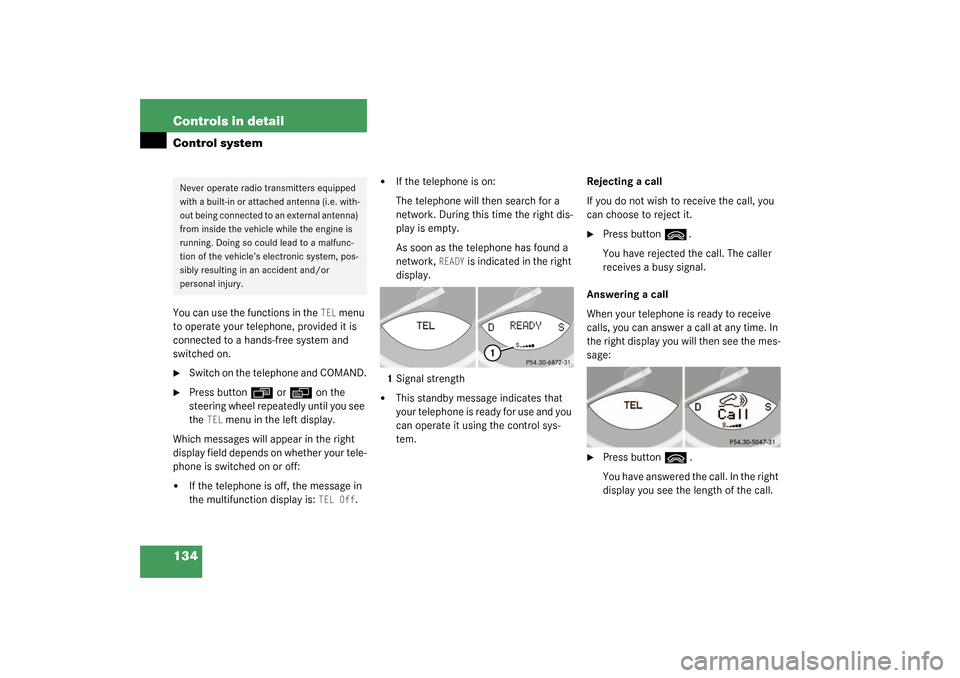
134 Controls in detailControl systemYou can use the functions in the
TEL
menu
to operate your telephone, provided it is
connected to a hands-free system and
switched on.
�
Switch on the telephone and COMAND.
�
Press button
ÿ
or
è
on the
steering wheel repeatedly until you see
the
TEL
menu in the left display.
Which messages will appear in the right
display field depends on whether your tele-
phone is switched on or off:
�
If the telephone is off, the message in
the multifunction display is:
TEL Off
.
�
If the telephone is on:
The telephone will then search for a
network. During this time the right dis-
play is empty.
As soon as the telephone has found a
network,
READY
is indicated in the right
display.
1Signal strength
�
This standby message indicates that
your telephone is ready for use and you
can operate it using the control sys-
tem.Rejecting a call
If you do not wish to receive the call, you
can choose to reject it.
�
Press button
ì
.
You have rejected the call. The caller
receives a busy signal.
Answering a call
When your telephone is ready to receive
calls, you can answer a call at any time. In
the right display you will then see the mes-
sage:
�
Press button
ì
.
You have answered the call. In the right
display you see the length of the call.
Never operate radio transmitters equipped
with a built-in or attached antenna (i.e. with-
out being connected to an external antenna)
from inside the vehicle while the engine is
running. Doing so could lead to a malfunc-
tion of the vehicle’s electronic system, pos-
sibly resulting in an accident and/or
personal injury.
Page 135 of 376
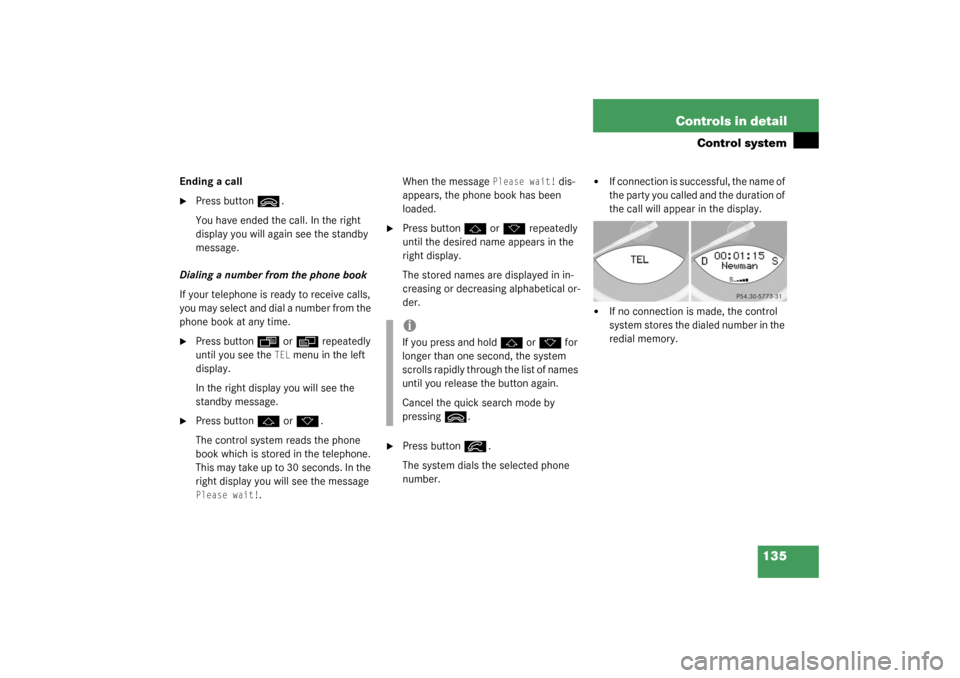
135 Controls in detail
Control system
Ending a call�
Press button
ì
.
You have ended the call. In the right
display you will again see the standby
message.
Dialing a number from the phone book
If your telephone is ready to receive calls,
you may select and dial a number from the
phone book at any time.
�
Press button
ÿ
or
è
repeatedly
until you see the
TEL
menu in the left
display.
In the right display you will see the
standby message.
�
Press button
j
or
k
.
The control system reads the phone
book which is stored in the telephone.
This may take up to 30 seconds. In the
right display you will see the message
Please wait!
.When the message
Please wait!
dis-
appears, the phone book has been
loaded.
�
Press button
j
or
k
repeatedly
until the desired name appears in the
right display.
The stored names are displayed in in-
creasing or decreasing alphabetical or-
der.
�
Press button
í
.
The system dials the selected phone
number.
�
If connection is successful, the name of
the party you called and the duration of
the call will appear in the display.
�
If no connection is made, the control
system stores the dialed number in the
redial memory.
iIf you press and hold
j
or
k
for
longer than one second, the system
scrolls rapidly through the list of names
until you release the button again.
Cancel the quick search mode by
pressing
ì
.
Page 136 of 376
136 Controls in detailControl systemRedialing
The control system stores the most recent-
ly dialed phone numbers. This eliminates
the need to search through your entire
phone book.�
Press button
ÿ
or
è
repeatedly
until you see the
TEL
menu in the left
display.
In the right display you will see the
standby message.
�
Press button
í
.
In the right display you see the first
number in the redial memory.
�
Press button
j
or
k
repeatedly
until the desired name appears in the
right display.
�
Press button
í
.
The control system dials the selected
phone number.
Page 137 of 376
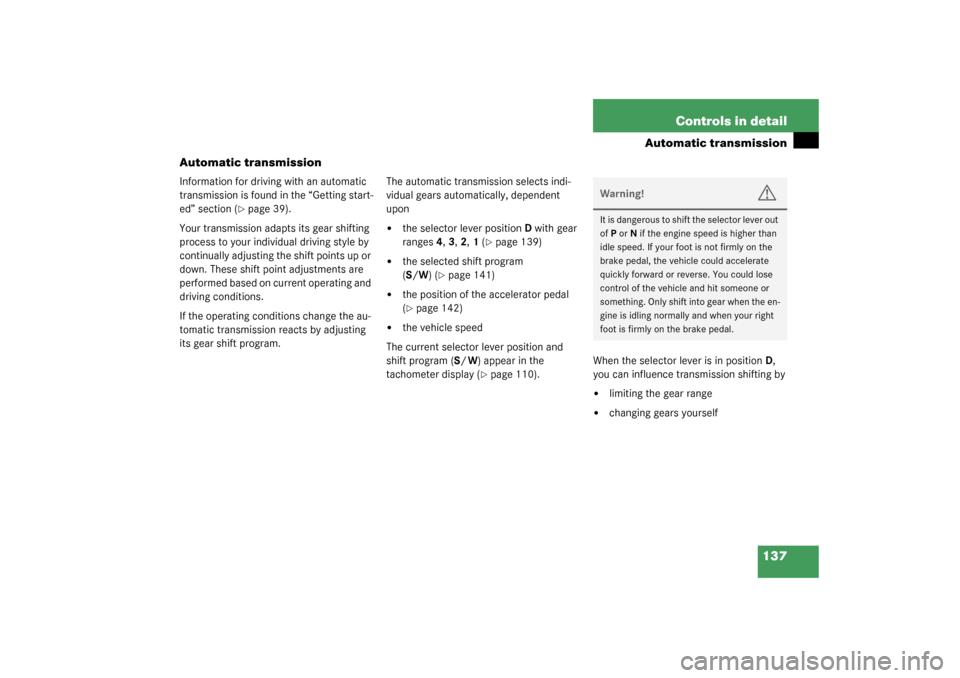
137 Controls in detail
Automatic transmission
Automatic transmission
Information for driving with an automatic
transmission is found in the “Getting start-
ed” section (
�page 39).
Your transmission adapts its gear shifting
process to your individual driving style by
continually adjusting the shift points up or
down. These shift point adjustments are
performed based on current operating and
driving conditions.
If the operating conditions change the au-
tomatic transmission reacts by adjusting
its gear shift program.The automatic transmission selects indi-
vidual gears automatically, dependent
upon
�
the selector lever positionD with gear
ranges4, 3, 2, 1 (
�page 139)
�
the selected shift program
(S/W)(
�page 141)
�
the position of the accelerator pedal
(�page 142)
�
the vehicle speed
The current selector lever position and
shift program (S/W) appear in the
tachometer display (
�page 110).When the selector lever is in positionD,
you can influence transmission shifting by
�
limiting the gear range
�
changing gears yourselfWarning!
G
It is dangerous to shift the selector lever out
ofP orN if the engine speed is higher than
idle speed. If your foot is not firmly on the
brake pedal, the vehicle could accelerate
quickly forward or reverse. You could lose
control of the vehicle and hit someone or
something. Only shift into gear when the en-
gine is idling normally and when your right
foot is firmly on the brake pedal.
Page 138 of 376
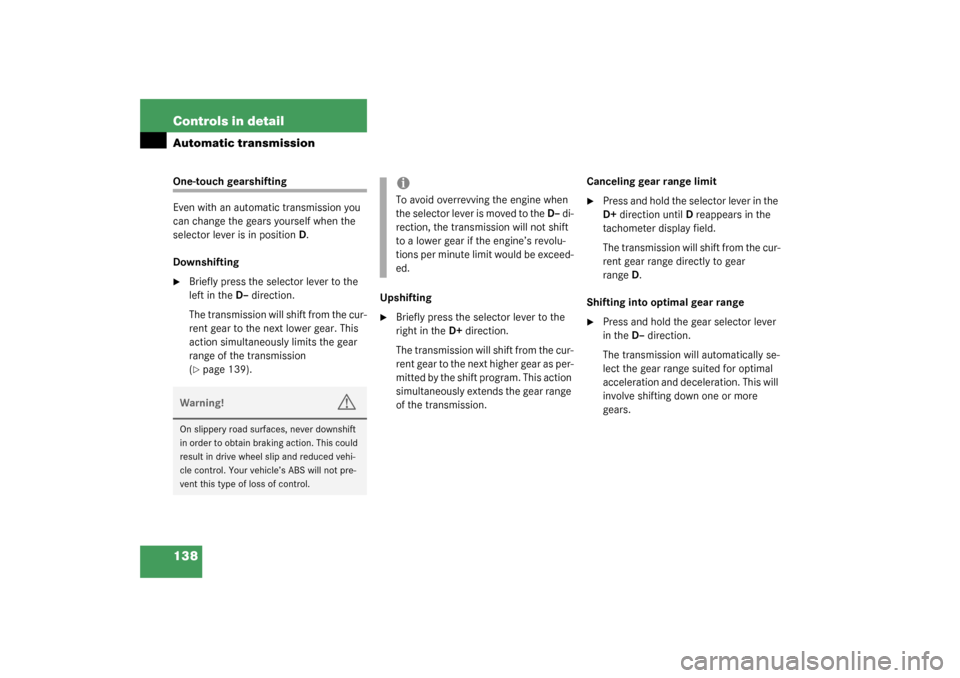
138 Controls in detailAutomatic transmissionOne-touch gearshifting
Even with an automatic transmission you
can change the gears yourself when the
selector lever is in positionD.
Downshifting�
Briefly press the selector lever to the
left in the D–direction.
The transmission will shift from the cur-
rent gear to the next lower gear. This
action simultaneously limits the gear
range of the transmission
(�page 139).Upshifting
�
Briefly press the selector lever to the
right in the D+direction.
The transmission will shift from the cur-
r e n t g e a r t o t h e ne x t h i g h e r g e a r a s p e r -
mitted by the shift program. This action
simultaneously extends the gear range
of the transmission.Canceling gear range limit
�
Press and hold the selector lever in the
D+direction until D reappears in the
tachometer display field.
The transmission will shift from the cur-
rent gear range directly to gear
rangeD.
Shifting into optimal gear range
�
Press and hold the gear selector lever
in the D– direction.
The transmission will automatically se-
lect the gear range suited for optimal
acceleration and deceleration. This will
involve shifting down one or more
gears.
Warning!
G
On slippery road surfaces, never downshift
in order to obtain braking action. This could
result in drive wheel slip and reduced vehi-
cle control. Your vehicle’s ABS will not pre-
vent this type of loss of control.
iTo avoid overrevving the engine when
the selector lever is moved to the D– di-
rection, the transmission will not shift
to a lower gear if the engine’s revolu-
tions per minute limit would be exceed-
ed.
Page 139 of 376

139 Controls in detail
Automatic transmission
Gear ranges
With the selector lever in positionD, you
can limit the transmission’s gear range by
pressing the lever to the left (D-), and re-
verse the gear range limit by pressing the
lever to the right (D+).
The selected gear range will appear in the
tachometer display field. If you press on
the accelerator when the engine has
reached its rpm limit, the transmission will
upshift beyond any gear range limit
selected.
Gear
range
Effect
é
The transmission shifts
through fourth gear only.
è
The transmission shifts
through third gear only.
With this selection you can
use the braking effect of the
engine.
Gear
range
Effect
ç
The transmission shifts
through second gear only.
Allows the use of the engine’s
braking power when driving �
on steep downgrades
�
in mountainous regions
�
under extreme operating
conditions
æ
The transmission operates
only in first gear.
For maximum use of the en-
gine’s braking effect on very
steep or lengthy downgrades.
Page 141 of 376
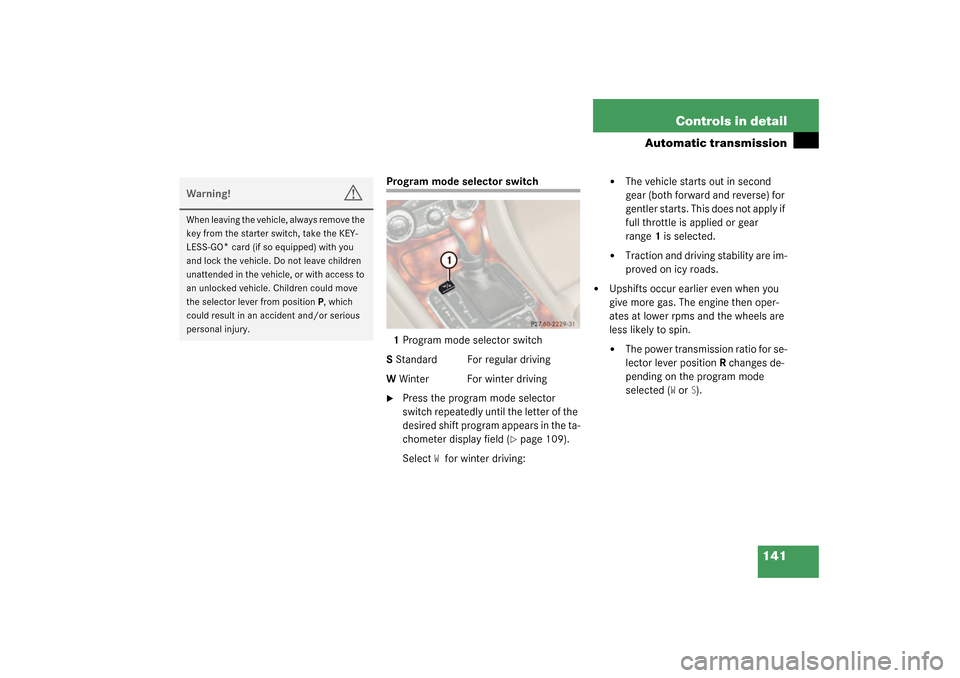
141 Controls in detail
Automatic transmission
Program mode selector switch
1Program mode selector switch
S Standard For regular driving
W Winter For winter driving�
Press the program mode selector
switch repeatedly until the letter of the
desired shift program appears in the ta-
chometer display field (
�page 109).
Select
Wfor winter driving:
�
The vehicle starts out in second
gear (both forward and reverse) for
gentler starts. This does not apply if
full throttle is applied or gear
range1 is selected.
�
Traction and driving stability are im-
proved on icy roads.
�
Upshifts occur earlier even when you
give more gas. The engine then oper-
ates at lower rpms and the wheels are
less likely to spin.�
The power transmission ratio for se-
lector lever positionR changes de-
pending on the program mode
selected (
W or
S).
Warning!
G
When leaving the vehicle, always remove the
key from the starter switch, take the KEY-
LESS-GO
* card (if so equipped) with you
and lock the vehicle. Do not leave children
unattended in the vehicle, or with access to
an unlocked vehicle. Children could move
the selector lever from positionP, which
could result in an accident and/or serious
personal injury.
Page 142 of 376
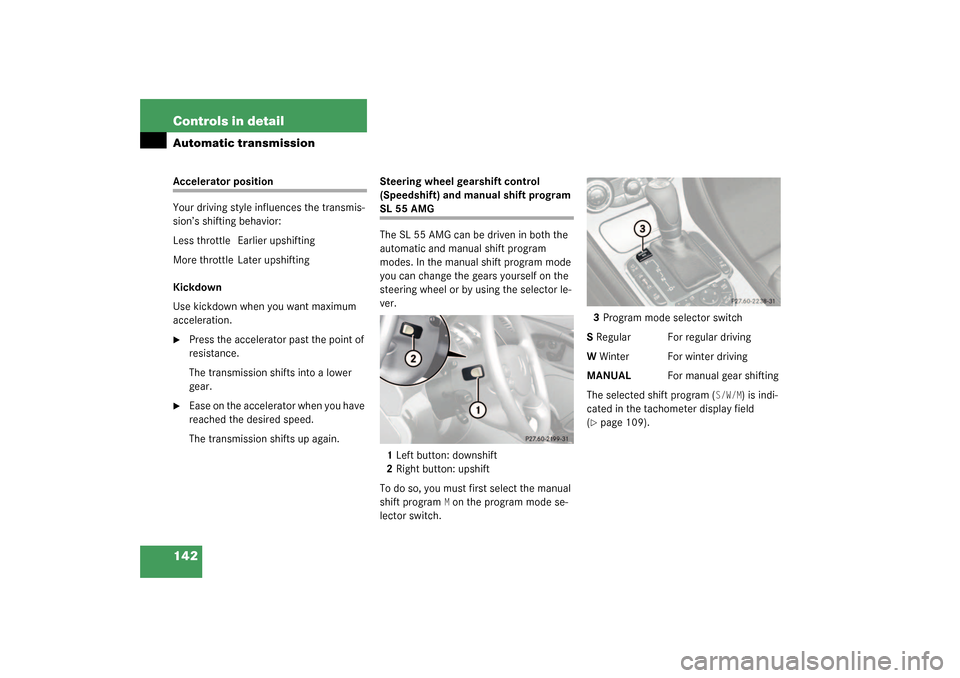
142 Controls in detailAutomatic transmissionAccelerator position
Your driving style influences the transmis-
sion’s shifting behavior:
Less throttle Earlier upshifting
More throttle Later upshifting
Kickdown
Use kickdown when you want maximum
acceleration.�
Press the accelerator past the point of
resistance.
The transmission shifts into a lower
gear.
�
Ease on the accelerator when you have
reached the desired speed.
The transmission shifts up again.Steering wheel gearshift control
(Speedshift) and manual shift program
SL 55 AMG
The SL 55 AMG can be driven in both the
automatic and manual shift program
modes. In the manual shift program mode
you can change the gears yourself on the
steering wheel or by using the selector le-
ver.
1Left button: downshift
2Right button: upshift
To do so, you must first select the manual
shift program
M on the program mode se-
lector switch.3Program mode selector switch
S Regular For regular driving
W Winter For winter driving
MANUALFor manual gear shifting
The selected shift program (
S/W/M
) is indi-
cated in the tachometer display field
(
�page 109).